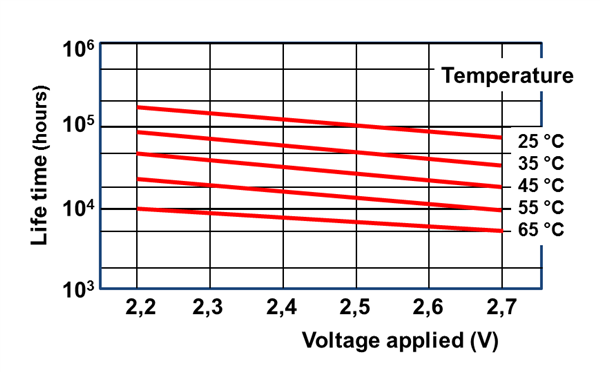The proliferation of applications needing momentary backup power has contributed to an increase in demand for supercapacitors. Supercapacitors, also known as ultracapacitors, are electrochemical capacitors with the ability to store more energy than regular capacitors. They can be charged and provide energy much faster than batteries. Figure 1 compares conventional capacitors, supercapacitors, conventional batteries and fuel cells in terms of power and energy density.
Figure 1: Energy versus power density for different energy-storage devices
A significant advantage of supercapacitors is their ability to withstand thousands of cycles before degrading, compared to hundreds of cycles for batteries. Also, Supercapacitors have the ability to be deeply discharged when compared to batteries as shown in Figure 2. However, because of the decomposition voltage of the electrolyte, most supercapacitors have a maximum rating of 2.7V-3V. Figure 2 compares the charge/discharge profiles of supercapacitors and batteries.
Figure 2: Charge/discharge cycles of supercapacitors and batteries
Recent developments in supercapacitors have led to the introduction of lithium-ion hybrid capacitors chargeable to a higher voltage (up to 4V) with less self-discharge and thus greater energy density. A disadvantage with these kinds of supercapacitors is their inability to be discharged to lower than about 2.2V without becoming damaged.
The composition of supercapacitors makes their self-discharge rate significantly higher than batteries. The greater the operating temperature under which a supercapacitor operates and the higher the voltage to which they’re charged, the faster the aging process; the capacitance of the supercapacitor decreases and the equivalent series resistance (ESR) increases. This means that the amount of energy that the supercapacitor can provide for an application diminishes. Equation 1 expresses the energy of a supercapacitor as:
W is the energy provided by the supercapacitor, C is the capacitance of the supercapacitor and V is the voltage of the supercapacitor. The ESR of the capacitor contributes to the power losses of the system.
Figure 3 shows the effect of temperature and voltage on the aging of a supercapacitor. Just a 10° temperature increase can cut the life expectancy of a supercapacitor by half. Also, it’s common practice to charge the supercapacitor to a voltage lower than the nominal to increase its longevity.
Figure 3: Life span versus cell voltage of supercapacitors at different temperatures
Since the maximum voltage to which a supercapacitor can be charged is between 2.7V and 3V, it is necessary to connect several supercapacitors in series for most applications. Thus, you must balance the supercapacitors; otherwise one unit could be charged more than the other and lead to unequal capacitor aging, subsequently reducing the pack’s ability to provide the required energy for the application.
Among the several methods employed in balancing supercapacitors are passive balancing using resistor strings, using switched resistors, using Zener diodes and active balancing. The first three methods result in power losses in the resistors, while the fourth method is the most efficient but also the costliest.
When supercapacitors are used in backup power applications, you must monitor their capacitance and ESR to ensure that they can provide the minimum required energy the application demands. TI’s bq33100 is a supercapacitor manager that can keep track of the capacitance and ESR of the supercapacitor bank; it also monitors other vital statistics such as temperature, voltage, current and safety conditions. The bq33100 can notify the host if the capacitor bank is weak and also carry out balancing. The bq24640, a high-efficiency switch-mode supercapacitor charger, has the ability to charge capacitor banks from 2.1V to 26V.
TI’s supercapacitor manager reference design (TIDA-00258) is a system solution for evaluating and monitoring supercapacitors. It incorporates a linear charger reference design and the bq33100 super capacitor manager. Next time you are evaluating a back-up power supply for your design, consider the power of supercapacitors!




